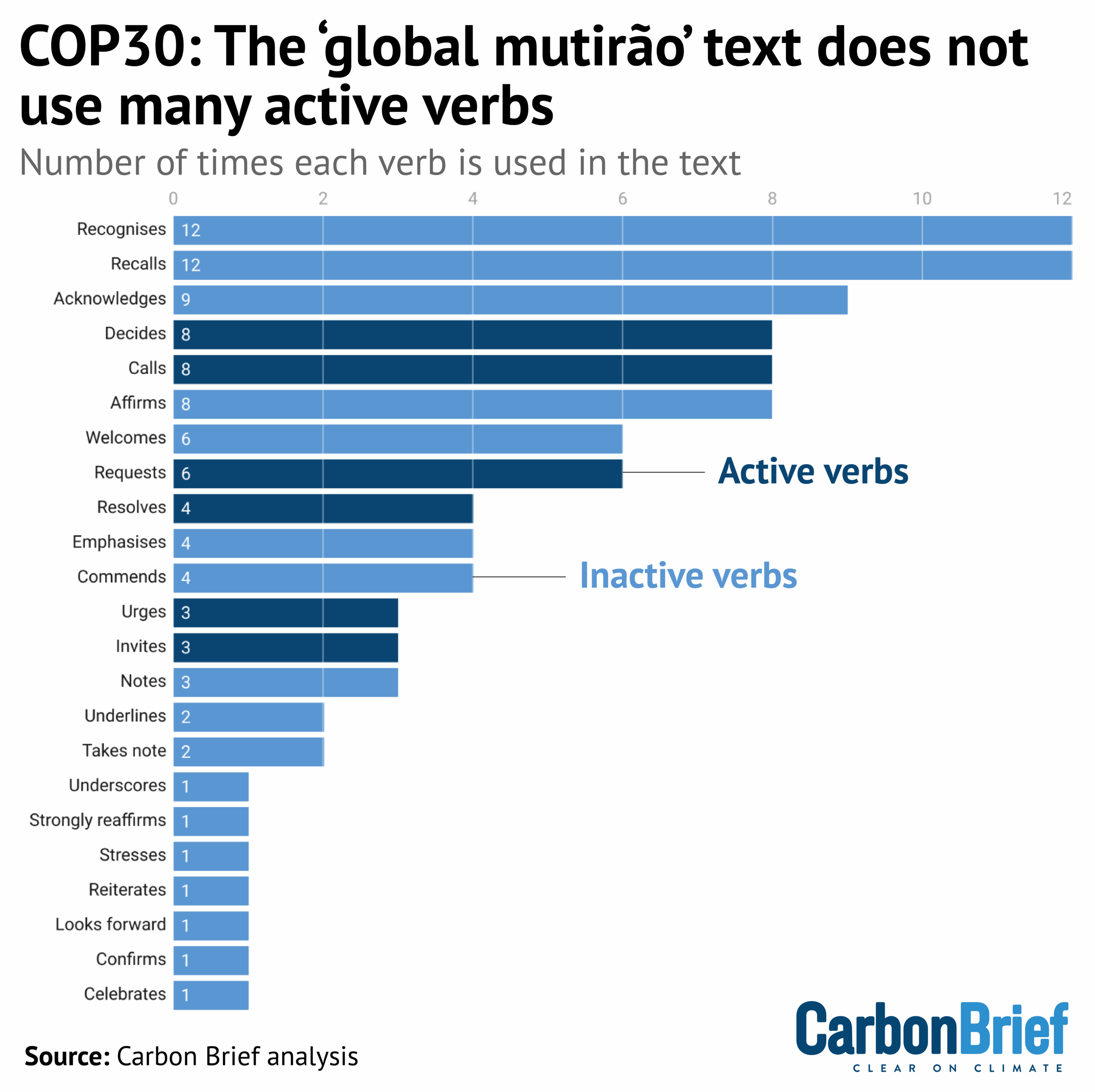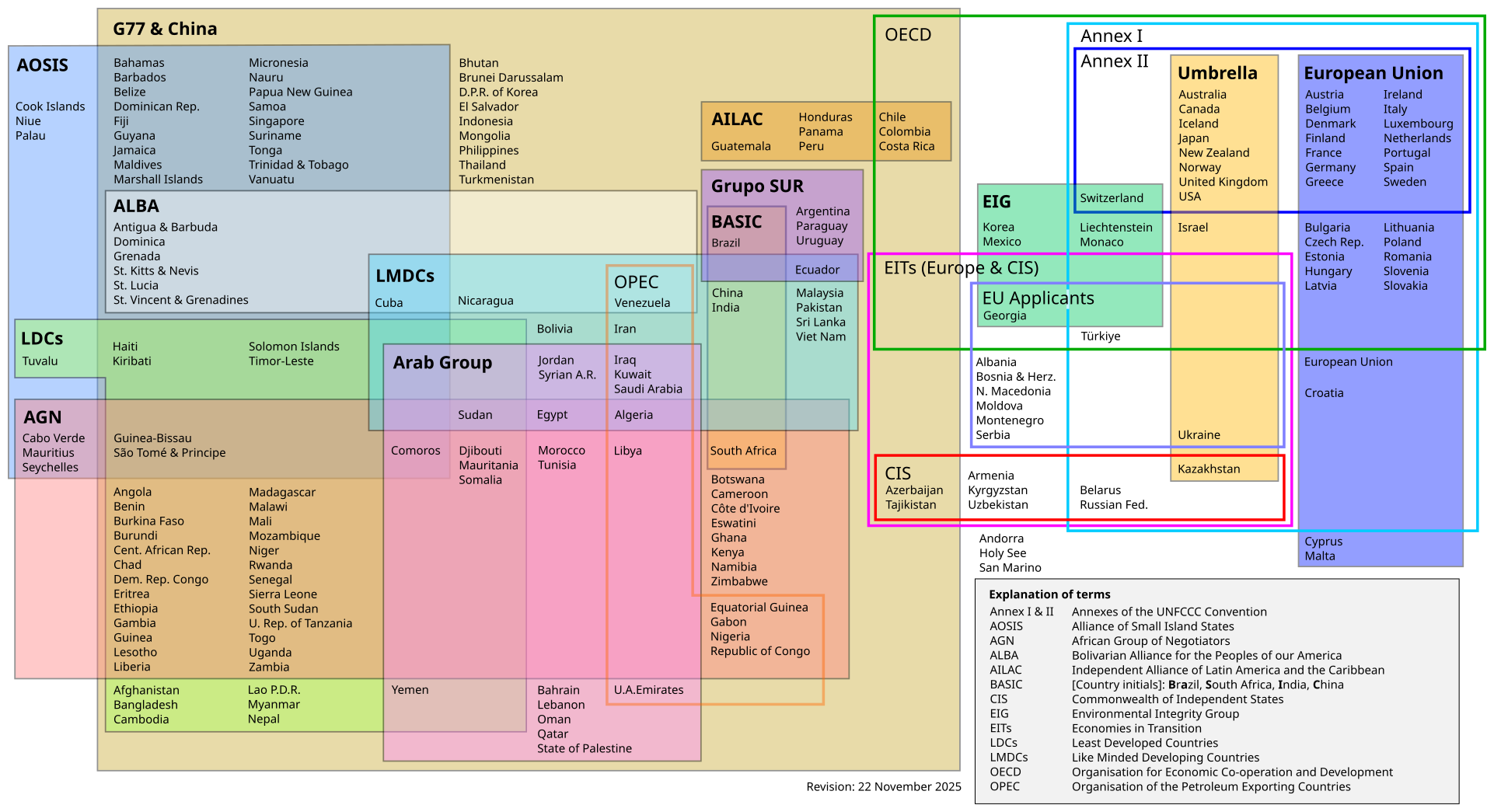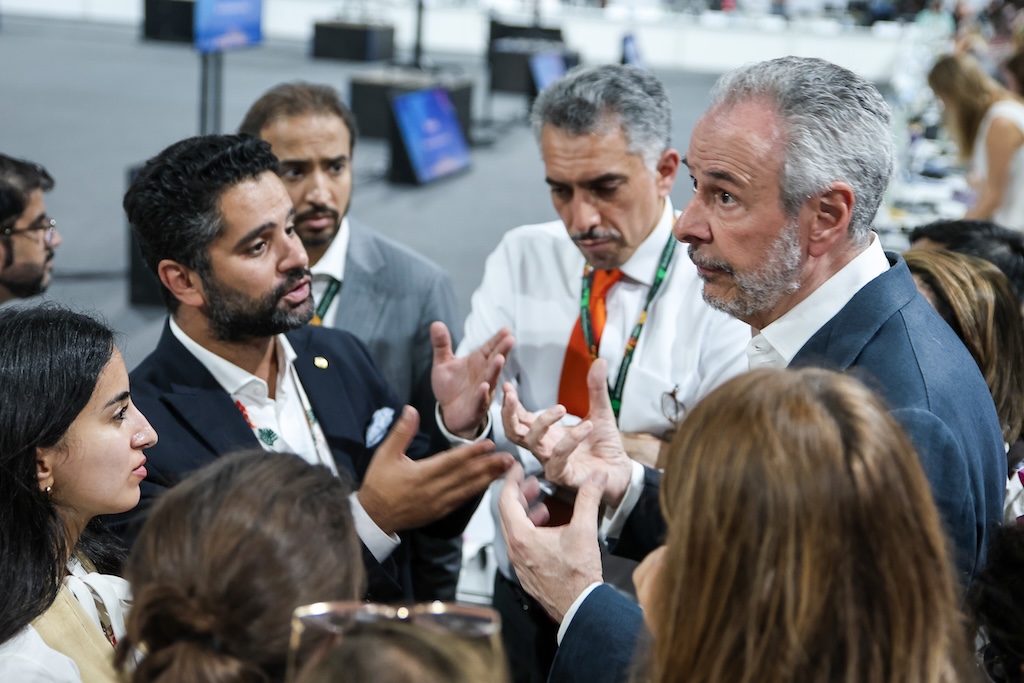Spiking food prices have made headlines around the world this year, from eggs in the US to vegetables in India.
The UN Food and Agriculture Organization’s Food Price Index has been slowly increasing over the past six months following declines over much of 2023.
For example, the price of orange juice concentrate in the US was 42% higher in April than it was a year ago, while the price of fresh orange juice in the UK has risen 25% over the last year.
In Greece, the price of olive oil rose by nearly 30% over 2023 and by more than 63% in April of this year.
No single factor alone can explain the rising prices.
But geopolitical conflict, extreme weather events, high input costs and increased demand are all playing a role.
The FAO’s recent Food Outlook report finds that, despite positive forecasts, “global food production systems remain vulnerable to shocks stemming from extreme weather events, geopolitical tensions, policy changes and developments in other markets”.
Carbon Brief has asked a range of scientists and policy experts from around the world what they think are the biggest factors driving spiking global food prices.
These are their responses, first as sample quotes, then, below, in full:
- Prof Elizabeth Robinson: “Whilst one can argue that food crises are not primarily caused by climate or weather, often food price spikes are due to a combination of weather and non-weather related factors.”
- Levi Sucre: “The overexploitation of agricultural lands and the intensive use of agrochemicals have led to a growing need for fertilisers to maintain production, which further increases production costs.”
- Dr Álvaro Lario: “Most food commodity markets present a stable outlook for 2024-25, which should help contain prices for consumers. However…many factors can tip the delicate demand-supply balance.”
- Siraj Hussain: “For long-term and stable food security, the yield has to go up and food losses have to come down.”
- Prof Andrew Challinor: “Put plainly, climate change is beginning to outpace us because it is interacting with our complex interrelated economic and food systems.”
- Dr Rob Vos: “Food prices in global markets are most sensitive to weather conditions and supply disruptions in major producing countries.”
- Prof Alan Matthews: “The rapid recovery of consumer demand following the disruptions caused by the measures to contain the Covid-19 pandemic, extreme weather events, animal disease outbreaks and tight global markets all contributed.”
- Xiomara Paredes: “In short, every time a new regulation is created, it increases production costs, makes market access difficult and thus makes food products more expensive.”
- Dr Manuel Otero: “Food prices have experienced significant increases due to various interrelated economic, social, environmental and political causes.”
- Dr Shouro Dasgupta: “Conflicts are one of the main reasons behind price shocks…Many of these events have also disrupted supply chains and infrastructure.”
 Prof Elizabeth Robinson
Prof Elizabeth Robinson
Director, Grantham Research Institute on Climate Change and the Environment.
London School of Economics and Political Science
Back in 2008, broad underinvestment in the agriculture sector, increasing demand for biofuels, changing diets and speculation – encouraged by declining global food stocks – were already putting longer-term upward pressure on food prices.
The 2008 food crisis was triggered by sequential poor wheat harvests in Australia, a breadbasket country. However, the extreme spike in wheat and rice prices was driven by a combination of export restrictions, panic buying and increased speculation, which amplified the short-term harvest shocks and the longer-term pressures.
More recently, the changing climate, the Covid-19 pandemic and Russia’s invasion of Ukraine have disrupted food production and globally integrated food supply chains, putting rapid upwards pressure on food prices. Whilst one can argue that food crises are not primarily caused by climate or weather, often food price spikes are due to a combination of weather and non-weather related factors.
Earlier this year cocoa prices rapidly increased, a consequence of extreme weather conditions, linked in part to El Niño, resulting in multiple poor harvest seasons in west Africa, combined with longer-term pressures, including disease and ageing cocoa trees, and short-term pressures, particularly speculation, exacerbating the situation further.
Given the changing climate, and in particular increasing extremes of heat and precipitation, food price spikes are likely to be an increasingly common feature of our highly integrated global food systems, in which shocks in one part of the world can relatively easily be amplified and transmitted around the globe.
 Levi Sucre
Levi Sucre
Coordinator
Mesoamerican Alliance of Peoples and Forests
There are several factors causing the increase in food prices worldwide.
Firstly, the high dependency on oil, whose price keeps rising, drives up the costs of food production and transportation. Agricultural machinery, fertilisers and product transportation rely heavily on oil, so any increase in its price directly affects the final cost of food.
Additionally, the overexploitation of agricultural lands and the intensive use of agrochemicals have led to a growing need for fertilisers to maintain production, which further increases production costs.
Monocultures are also degrading the soil, reducing its capacity to produce food sustainably. The lack of crop rotation depletes soil nutrients, diminishing its fertility and forcing farmers to use more fertilisers and pesticides. This not only increases costs but also has negative effects on the environment and health.
The effects of climate change are impacting agricultural production; for example, rising temperatures are disrupting previously predictable agricultural seasons, making crop production more difficult. High temperatures in Mesoamerica continue to destroy crops and reduce food reserves, worsening shortages and driving up prices, affecting nearly 8 million people in El Salvador, Guatemala, Honduras and Nicaragua.
Furthermore, economic injustice, inequality and lack of equity exacerbate the situation. The people with the least resources are the most affected by rising food prices, putting their food security at risk. On the other hand, small-scale producers, who do not use harmful soil practices, do not receive the necessary support to increase their production. These farmers cannot compete with large companies that dominate the market with their monocultures.
 Dr Álvaro Lario
Dr Álvaro Lario
President
International Fund for Agricultural Development
International food prices have declined since their historic peak after the start of the war in Ukraine. According to the recently released biennial FAO Food Outlook, most food commodity markets present a stable outlook for 2024-25, which should help contain prices for consumers. But as the report reminds us, many factors can tip the delicate demand-supply balance, impacting food prices and global food security.
The drop in global food prices does not automatically mean that prices have decreased in real terms in local markets, especially considering the strong depreciation of local currencies in most low- and middle-income countries against a robust US dollar.
This is also true for rural communities in these countries, where 80% of the world’s poorest live. In these areas, people can spend up to 70% of their income on food, leaving them with no capacity to absorb any price hikes and pushing them into poverty and hunger. Since Covid-19 emerged, we have seen multiple crises, such as climate change, conflict and record-high food prices, have compounded to push 122 million more people into hunger.
And, despite the current trend, we must remember how fragile our food systems are. They are increasingly threatened by more frequent and intense weather extremes, and volatile geopolitics. Our food systems are overly concentrated on a few crops, countries and producers, and are inefficient, with significant food losses along the value chain and high levels of food waste at the consumer level.
 Siraj Hussain
Siraj Hussain
India’s former agricultural secretary. Trustee.
World Food Programme Trust for India
Food inflation has been a source of major concern for a vast majority of Indians.
It is quite an enigma that even cereals, in which India is surplus, have seen double-digit inflation in the last year. Despite the erratic monsoon in 2023, India produced 137m tonnes of rice. Yet in every month since April 2023, the consumer price index inflation for rice was 11-13%.
In the case of wheat, inflation was more than 12% from April to July 2023. The Indian government released 10m tonnes of wheat under an open market sales scheme to cool down wheat prices and the intervention was quite successful as inflation has come down to about 3-7% since July 2023.
The reasons behind inflation in basic cereals of wheat and rice are not well understood. Despite low monsoon rains in 2023-24 due to El Niño, the production of both was not too low in 2023-24. As per the Indian government, wheat production was 113m tonnes.
The real concern in the basket of food inflation comes from vegetables, where inflation in the last year has reached more than 25%. This is attributed to losses in the supply chain from harvesting to marketing. India’s food surpluses are quite small except for rice and sugar. For long-term and stable food security, the yield has to go up and food losses have to come down.
 Prof Andy Challinor
Prof Andy Challinor
Professor of Climate Impacts.
University of Leeds
Every five years, the UK is mandated to report on climate change risks. The scientific evidence for the second of these reports was published in 2017. It highlighted risks from weather-related shocks to international food production and trade as a key risk.
The final report, which is the responsibility of the government, not scientists, endorsed all the conclusions of the evidence report “with the exception of some of those on food security”. The reason? It said: “The government takes a more optimistic view of the levels of resilience that are achieved through functioning markets and diverse sources of supply.”
In the same month that the government response was written, reports of a UK courgette deficit, resulting from climate extremes abroad, soon deepened into wider concerns across a range of vegetables and rationing was commonplace across supermarkets. The World Economic Forum’s 2017 report on global risks identified extreme weather events – already ranked as the most likely global risk in every WEF report since 2014 – as both the most likely and most impactful risk, after weapons of mass destruction.
Skip forward to 2022, when the evidence for the new UK assessment was published. Amongst other additions, an increased underlying vulnerability to climate risk was identified along with a new specific risk of “risk amplification from the interactions and cascades of named risks across systems and geographies”.
The way we as a society (consumers, citizens, government, businesses) choose to set up our food systems has huge implications for stability and resilience – or lack thereof. The 2022 report makes clear that the UK is struggling to keep pace with climate change impacts because of both the pace of change and the way in which the many potential risks to food systems interact with each other.
Put plainly, climate change is beginning to outpace us because it is interacting with our complex interrelated economic and food systems. Until we find ourselves able to look at the big picture and adjust accordingly, we can expect more of the same.
 Dr Rob Vos
Dr Rob Vos
Director for Markets, Trade and Institutions.
International Food Policy Research Institute
The war in Ukraine caused world market prices for staple foods, especially wheat and vegetable oils, to skyrocket in the first half of 2022. Since then, however, those world market prices have come down to pre-war levels.
At the same time, consumers around the world have felt soaring domestic food price inflation well into 2023. People in some low- and middle-income countries, such as in Argentina, Egypt, Ethiopia, Gaza, Haiti, Sudan, Ukraine and Venezuela, are still seeing the cost of their daily bread and meals going up at high rates today.
What is driving these price fluctuations in global food markets and why are consumer prices not following the same pattern?
Food prices in global markets are most sensitive to weather conditions and supply disruptions in major producing countries. For instance, floods in India caused by the El Niño phenomenon disrupted rice production in India during 2023, pushing up rice prices worldwide.
The war in Ukraine caused shortages in global wheat, maize, sunflower seeds and fertiliser supplies as both Russia and Ukraine are major producers, pushing up wheat, vegetable oil and fertiliser prices.
I should add that the Ukraine war was not the only factor and, in fact, just exacerbated the surge in international food and fertiliser prices induced by the global economic recovery from the Covid-19 recession and the supply chain disruptions (recall the containership pile-up at harbours) that sent oil prices and shipping costs soaring and increasing the cost of farming and food trade worldwide.
Global market prices are further sensitive to misguided policy responses. Governments often respond to expected food supply shortages and price surges by imposing restrictions on exports (such as India’s bans on rice exports in 2023) or lowering import restrictions (as many rice-importing countries did in 2023). While trying to protect their consumers, these “insulation” measures end up just magnifying the price increase.
Why do domestic food prices not necessarily follow the same pattern?
In fact, most countries are relatively insulated from global price shocks as they rely predominantly on their own food production to feed their populations; typically, only 10-15% or less of food consumption is imported.
Domestic conditions for food production and distribution systems thus matter more than global prices. These conditions vary across countries, but countries with the highest rates of consumer price inflation have seen food systems disrupted by intensified conflict (as in Ethiopia, Gaza, Haiti and Sudan, for instance) and those suffering macroeconomic constraints and weak currencies that have kept both general and food price inflation high (e.g. Argentina, Venezuela, Turkey, and many highly indebted low-income countries).
 Prof Alan Matthews
Prof Alan Matthews
Professor Emeritus of European Agricultural Policy
University of Dublin Trinity College
Food prices in the EU rose dramatically in 2022 and 2023. EU food prices were 41% higher in May 2023 relative to the price level in 2015, while the overall price level rose by just 26% during this period. The monthly annual rate of food price inflation peaked at 19.2% in the EU in March 2023.
Even higher rates were recorded in central and eastern Europe, with Hungary a particular outlier, with food price inflation of 46% in February 2023. Since then, food prices have not fallen, but are now increasing at a rate below the general inflation rate for the first time in two years.
There have been multiple drivers of this food price inflation. The rapid recovery of consumer demand following the disruptions caused by the measures to contain the Covid-19 pandemic, extreme weather events, animal disease outbreaks and tight global markets all contributed.
For Europe, the impact of the Russian invasion of Ukraine has been particularly important. There was a direct impact through the increased price of energy, and thus fertilisers and fuel, given the EU’s dependence on imports particularly of Russian gas, but also an indirect impact through the knock-on effect of higher world market crop prices due to the subsequent curtailment of Ukrainian exports to the world market.
Extreme weather events have contributed to food price increases. High temperatures and drought badly affected olive oil production in 2022-23 as well as production of cereals in southern Europe, while heavy rains and wet weather have delayed planting and harvests and damaged fruit quality in northern Europe.
Despite these production losses, a March 2024 study in Communications Earth & Environment estimated that the 2022 extreme summer heat had increased food inflation in Europe by 0.43-0.93 percentage points – so making a relatively minor contribution to the overall 19% increase in food prices at that time. Nonetheless, in more normal times that would cause a more noticeable uptick in food prices, and the authors suggest that the warming projected for 2035 could amplify these numbers by 30-50%.
Xiomara Paredes
Executive Director, Latin American and Caribbean Coordinating Association of Small Fair Trade Producers and Workers
The new regulations that the EU has recently implemented, such as the deforestation-free regulation, changes in organic regulation, human rights and environmental due diligence, entail the investment of additional resources, thus raising production costs.
For example, to comply with the deforestation-free regulation, producers must first invest in geolocation equipment and have technical staff who can survey the points or polygons on the plots of each producer member of the organisation. Geolocating all the producers’ plots also takes time and effort that must be diluted in the installed capacity of the producer organisations.
In short, every time a new regulation is created, it increases production costs, makes market access difficult and thus makes food products more expensive.
 Dr Shouro Dasgupta
Dr Shouro Dasgupta
Environmental Economist
Fondazione CMCC
Visiting Senior Fellow
Grantham Research Institute, LSE
The issue of increasing food prices is multifaceted and is due to a complex set of reasons including conflicts, climate change and supply chain disruptions.
Conflicts are one of the main reasons behind price shocks. For instance, Russia’s invasion of Ukraine, known as the breadbasket of Europe, has substantially reduced exports of wheat, maize and sunflower, resulting in food price fluctuations. While global food prices have decreased from their peak levels at the onset of the conflict, they remain higher than the pre-conflict levels.
Climate change, manifested by increasing temperatures and the increasing intensity and frequency of extreme events such as heatwaves, droughts and floods, has led to crop failures and reduced yields in many parts of the world. This, in turn, has pushed up food prices through supply shocks.
Many of these events have also disrupted supply chains and infrastructure, such as roads, and lowered water levels of major rivers such as the Rhine. Whether due to conflicts or climate change, several countries have imposed export bans on major agricultural commodities (for example, India, Myanmar and Russia on rice; Thailand on sugar; Argentina on beef). These restrictions affect countries that are highly dependent on imports the most.
Several policy failures in the global food system also contribute to food inflation. One such issue is the inadequacy of storage facilities, especially in low- and middle-income countries. Another is the concentration of food production in certain regions and on selected crops (60% of the plant-based calorie intake is provided by rice, wheat and maize) and the fact that global food chains are dominated by a small number of multinational corporations.
Dr Manuel Otero
Director-general, Inter-American Institute for Cooperation on Agriculture
In recent years, food prices have experienced significant increases due to various interrelated economic, social, environmental and political causes. Armed conflicts have disrupted supply chains and food production and distribution, exacerbating shortages and driving up prices. These conflicts have also displaced millions of people, affecting their ability to produce and access food.
Economic shocks, such as the Covid-19 pandemic and its repercussions, plus the slowdown of economies, have reduced consumers’ purchasing power, decreasing incomes and increasing unemployment, which has raised relative demand and prices.
Extreme weather events, such as droughts and storms, have affected agricultural production, reducing supply and increasing production costs, resulting in higher prices for consumers. Volatility in fertiliser markets, driven by trade restrictions and armed conflict, has also increased agricultural production costs, reflected in higher prices for food products.
Trade restrictions, such as export bans, have exacerbated the global food crisis, limiting international food trade and further driving up prices in global markets. According to our Observatory of Public Policies for Agrifood Systems tool, since the pandemic, food inflation has reached 28% annually on a global average – compared to a general inflation of 19% annually.
This is despite the fact that international food prices fell 9% annually for the same comparison period, suggesting that other economic, political and environmental factors contribute to food inflation.
Latin America and the Caribbean is home to 16 net-exporting and 16 net-food-importing countries, so the region has benefited from the increase in international food prices, but has also been one of the most affected by food insecurity due to factors such as increasing poverty.
The post Experts: What is causing food prices to spike around the world? appeared first on Carbon Brief.
Experts: What is causing food prices to spike around the world?
Climate Change
EU refuses to review “strategic” mineral projects for energy transition
The European Commission has rejected requests by green groups to review the status of 16 controversial projects it has designated as “strategic” to shore up the bloc’s supply of critical minerals needed for the energy transition, despite environmental concerns.
Campaigners accused the European Union’s executive arm of being more interested in labelling projects as “strategic” to accelerate their development than ensuring they meet its environmental standards.
Legal experts told Climate Home News that despite the EU’s rhetoric on developing sustainable mining standards, it will be very difficult for local communities and NGOs to use the judicial system to enforce compliance with environmental safeguards.
Earlier this year, the European Commission labelled 47 mineral extraction, processing and recycling projects within EU member states as “strategic“, granting them preferential treatment for gaining permits and easier access to EU funding.
Spanning from the north of Sweden to Portugal and southern Spain, these projects are due to help the EU reach targets for sourcing more of the minerals it needs for clean energy and digital technologies within its own borders in an environmentally friendly way, while reducing its dependence on imports from China.
However, NGOs and local communities have accused the European Commission of a lack of transparency and of failing to engage civil society over the selection of these projects, most of which are in the early stages of development and are yet to obtain the necessary permits or conduct detailed environmental impact assessments.
Civil society groups challenged the decision to include around a third of projects on the strategic list, arguing that the commission had not properly assessed their sustainability. They also cited risks of social and environmental harm and human rights violations.
EU: Environmental compliance lies with member states
In total, 11 requests for review covering 16 of the projects planned within the EU were filed under the Aarhus Regulation, which gives NGOs the right to ask the European Commission to review administrative decisions if they are considered to violate the bloc’s environmental law.
In a single response shared with green groups this week, and seen by Climate Home News, the commission found that the requests to review the projects’ status were “unfounded”.
“A thorough assessment confirmed that all points raised by the NGOs had already been properly addressed during the selection process. All the projects concerned therefore retain their status as strategic projects,” a European Commission spokesperson told Climate Home News. They did not respond to detailed questions about their assessment.
Under the EU’s Critical Raw Materials Act, which was adopted last year, the commission can designate mineral projects as strategic if they meet a shortlist of criteria, including that the project “would be implemented sustainably” and monitor, prevent and minimise environmental and adverse social impacts.
The strategic status can be revoked if projects no longer meet the criteria.
However, the commission said it was not its job to carry out a full and detailed assessment of whether the projects fully comply with EU environmental laws, adding that it is only required to make an “overall assessment”.
Rather, it argued, member states have the responsibility to ensure the projects fully comply with EU environmental standards including impacts on biodiversity and ground water as well as waste management.
The commission also refused to examine the social impacts of the projects on community livelihoods, health and human rights – which could arise from environmental degradation – arguing that this was outside the scope of the review mechanism under the Aarhus Regulation.
Campaigners have strongly criticised the response.
“Cosmetic”sustainability criteria
Ilze Tralmaka, a lawyer at Client Earth, told Climate Home News the commission’s decision showed that the designation of mineral projects as “strategic” doesn’t make them safe or sustainable, despite creating a legal presumption that they serve the public interest and protect public health and safety.
“While on paper, there is mention of sustainability, in practice, it’s almost cosmetic,” she said. “It seems the environmental standards are just briefly looked at and that the policy of declaring these projects as strategic is more important than real engagement with the sustainability criteria.”
Client Earth argues that while securing supplies of minerals for the energy transition is a legitimate goal, the status of strategic project is being “misused” to fast-track questionable mining projects.
Tralmaka said the European Commission should engage where there are “unanswered questions, or if there is credible information about these projects being potentially unsafe”.
Client Earth was part of a group of NGOs that challenged the decision to designate the Barroso lithium project in Portugal as a strategic project.


“Textbook example of how not to do a green transition”
London-listed Savannah Resources is planning to dig four open pit mines in the northern Barroso region to extract lithium from Europe’s largest known deposit. The company says it will extract enough lithium every year to produce around half a million batteries for electric vehicles.
However, local groups have staunchly opposed the mining project, citing concerns over waste management and water use as well as the impact of the mine on traditional agriculture in the area.
Earlier this year, a UN committee found that Portugal had failed to respect citizens’ rights to information and public participation in the case of the Barroso project. Portuguese authorities denied the breach.
Efforts to green lithium extraction face scrutiny over water use
The commission said it was satisfied with the project’s overall sustainability credentials and that campaign groups should take a case to their national court if they are concerned about the legality of any project.
“This decision shows that the EU is willing to trade rural lives and irreplaceable landscapes for a political headline,” said Nik Völker of MiningWatch Portugal. “The truth is, the Mina do Barroso mine offers minimal benefits and enormous risks: a textbook example of how not to do a green transition.”
Savannah Resources did not respond to a request for comment.
“Murky” standards make legal challenge hard
Simon Simanovski, a business and human rights attorney with German law firm Günther Rechtsanwälte, has advised dozens of communities affected by projects designated as “strategic” under the EU’s Critical Raw Materials Act over the past year.
For him, the commission’s response creates a disconnect between its role as a decision-making body and the responsibility for enforcing the bloc’s environmental laws, by pushing it to member states. That, he said, creates “murky standards”.
This, he added, will make it “really difficult” to challenge inadequate environmental safeguards through the courts. “It means that there is no effective judicial protection… and that the projects will happen,” he told Climate Home News.
However, Simanovski still expects some campaign groups to try filing a case before the general court of the European Court of Justice to challenge the European Commission’s response and ask it to review its assessment of the projects.
Simanovski represents communities in Serbia that are also challenging the “strategic” designation of the Jadar lithium mine – one of an additional 13 “strategic projects” located outside EU countries – which has seen massive local opposition.
The commission is expected to respond to requests to review those external strategic projects in January.
The post EU refuses to review “strategic” mineral projects for energy transition appeared first on Climate Home News.
EU refuses to review “strategic” mineral projects for energy transition
Climate Change
DeBriefed 28 November 2025: COP30’s ‘frustrating’ end; Asia floods; UK ‘emergency’ climate event
Welcome to Carbon Brief’s DeBriefed.
An essential guide to the week’s key developments relating to climate change.
This week
‘Lukewarm’ end to COP30
BYE BELÉM: The COP30 climate talks in Belém ended last weekend with countries agreeing on a goal to “triple” adaptation finance by 2035 and efforts to “strengthen” climate plans, Climate Home News reported. The final deal “fell short on the global transition away from oil, gas and coal”, the outlet said, as Brazil announced that it would bring forward voluntary roadmaps to phase out fossil fuels and deforestation, before the next COP. It was a “frustrating end” for more than 80 countries who wanted a roadmap away from fossil fuels to be part of the formal COP agreement, BBC News said.
WHAT HAPPENED?: Carbon Brief published its in-depth analysis of all the key outcomes from COP30, spanning everything from negotiations on adaptation, just transition, gender and “Article 6” carbon trading through to a round-up of pledges on various issues. Another Carbon Brief article summed up outcomes around food, forests, land and nature. Also, Carbon Brief journalists discussed the COP in a webinar held earlier this week.
ART OF THE DEAL: The “compromise” COP30 deal – known as the “global mutirão” – “exposed deep rifts over how future climate action should be pursued”, Reuters noted. The “last-ditch” agreement was reached after fossil-fuel wording negotiations between the EU and Saudi Arabia, according to the Guardian. Meanwhile, Carbon Brief revealed the “informal” list of 84 countries said to have “opposed” the inclusion of a fossil-fuel roadmap in the mutirão decision, but analysis of the list exposed contradictions and likely errors.
UNITY, SCIENCE, SENSE: The final agreement received “lukewarm praise”, said the Associated Press. Palau ambassador Ilana Seid, who chaired the coalition of small-island nations, told the newswire: “Given the circumstances of geopolitics today, we’re actually quite pleased…The alternative is that we don’t get a decision and that would have been [worse].” UN climate chief Simon Stiell said that amid “denial, division and geopolitics”, countries “chose unity, science and economic common sense”, reported the Press Trust of India.
Around the world
- Floods and landslides killed more than 200 people in Thailand and Indonesia this week, reported Bloomberg. At least 90 people also died in recent floods in Vietnam, said Al Jazeera.
- New measures to cut energy bills and a “pay-per-mile” electric-vehicle levy were among the announcements in the UK’s budget, said Carbon Brief.
- The Group of 20 (G20) leaders signed off on a declaration “addressing the climate crisis” and other issues, reported Reuters, which had no input from the US who boycotted last week’s G20 summit in South Africa.
- Canadian prime minister Mark Carney signed a deal with the province of Alberta “centred on plans for a new heavy oil pipeline”, said the Guardian, adding that Canadian culture minister and former environment minister, Steven Guilbeault, resigned from cabinet over the deal.
- Greenpeace analysis, covered by Reuters, found that permits for new coal plants in China are “on track to fall to a four-year low” in 2025.
27
The number of hours that COP30 talks went over schedule before ending in Belém last Saturday, making it the 11th-longest UN climate summit on record, according to analysis by Carbon Brief.
Latest climate research
- The risk of night-time deaths during heatwaves increased “significantly” over 2005-15 in sub-Saharan Africa | Science Advances
- Almost half of climate journalists surveyed showed “moderate to severe” symptoms of anxiety | Traumatology
- Lakes experienced “more severe” heatwaves than those in the atmosphere over the past two decades | Communications Earth & Environment
(For more, see Carbon Brief’s in-depth daily summaries of the top climate news stories on Monday, Tuesday, Wednesday, Thursday and Friday.)
Captured

The key COP30 agreement – termed the “global mutirão” – contained 69 inactive verbs, which require no action from countries, compared to 32 active ones. “Recognises”, “recalls” and “acknowledges” were used far more often than more active verbs, such as “decides”, “calls” and “requests”, showed Carbon Brief analysis.
Spotlight
Nine warnings from a UK climate and nature ‘emergency’ briefing
This week, Carbon Brief’s Orla Dwyer reports from an event where experts and campaigners sounded the alarm bell on climate change and nature loss.
Naturalist and broadcaster Chris Packham urged attendees at a climate and nature “emergency briefing” in London yesterday to “listen to the science” on climate change amid a “dangerous wave of misinformation and lies”.
The “first-of-its-kind” event heard from nine experts on the links between climate change, nature loss, health, food production, economics and national security.
Event host, Prof Mike Berners-Lee from Lancaster University, called for a “World War II level of leadership” to tackle the interconnected crises.
Hundreds of people showed up, including Green Party, Labour and Liberal Democrat MPs, leader of the Greens Zack Polanski, musician Brian Eno and actress Olivia Williams.
Here is a snapshot of what the nine speakers said in their short, but stark, presentations.
Prof Kevin Anderson, professor of energy at University of Manchester
Anderson focused on the risks of a warmer world and the sliver of emissions left in the global carbon budget, noting:
“We have to eliminate fossil fuels or temperatures will just keep going up.”
He urged a “Marshall-style” plan – referencing the 1948 post-war US plan to rebuild Europe – to ramp up actions on retrofitting, public transport and electrification.
Prof Nathalie Seddon, professor of biodiversity at University of Oxford
Nature is not a “nice to have”, but rather “critical national infrastructure”, Seddon told attendees. She called for the “need to create an economy that values nature”.
Prof Paul Behrens, British Academy global professor at University of Oxford
Behrens discussed the food security risks from climate change. Impacts such as poor harvests and food price inflation are “barely acknowledge[d]” in agricultural policy, he said.
He also emphasised the “unsustainable” land use of animal agriculture, which “occupies around 85% of total agricultural land” in the UK.
Prof Tim Lenton, chair in climate change and Earth system science at Exeter University
Lenton outlined the “plenty” of evidence that parts of the Earth system are hurtling towards climate tipping points that could push them irreversibly into a new state.
He discussed the possibility of the shutdown of the Atlantic Meridional Overturning Circulation, which he said could cause -20C winters in London. He also noted positive tipping points, such as momentum that led the UK to stop burning coal for electricity last year.

Prof Hayley Fowler, professor of climate change impacts at Newcastle University
One in four properties in England could be at risk of flooding by 2050, Fowler said, and winters are getting wetter.
She discussed extreme weather risks and listed the impacts of floods in recent years in Germany, Spain and Libya, adding:
“These events are not warnings of what might happen in the future. They’re actually examples of what is happening right now.”
Angela Francis, director of policy solutions at WWF-UK
Francis factchecked several claims made against climate action, such as the high cost of achieving net-zero.
She noted that the estimated cost for the UK to achieve net-zero is about £4bn per year, which is less than 0.2% of GDP.
Lieutenant general Richard Nugee, climate and security advisor
Discussing the risks climate change poses to national security, Nugee said:
“Climate change can be thought of as a threat multiplier, making existing threats worse or more frequent and introducing new threats. Climate shocks fuel global instability.”
Tessa Khan, environmental lawyer and executive director of Uplift
Khan said the rising cost of energy in the UK is “turning into a significant political risk for the energy transition”.
She discussed the cost of fossil-fuel dependency and the fact that these fuels cost money to burn, but renewable “input[s], sun or wind [are] free forever”.
Prof Hugh Montgomery, professor of intensive care medicine at University College London
Montgomery discussed the health and economic benefits of climate actions, such as eating less meat and using more public transport, noting:
“The climate emergency is a health emergency – and it’s about time we started treating it as one.”
Watch, read, listen
WATER WORRIES: ABC News spoke to three Iranian women about the impacts of Tehran’s water crisis amid the “worst drought in 60 years”.
CLIMATE EFFORT: The BBC’s Climate Question podcast looked at the main outcomes from COP30 and discussed the “future of climate action” with a team of panelists.
CRIMINAL BEHAVIOUR:New Scientist interviewed criminal psychologist Julia Shaw about the psychology behind environmental crimes.
Coming up
- 24 November-5 December: COP20 on international trade in endangered species of wild fauna and flora, Samarkand, Uzbekistan
- 29-30 November: First part of global youth environment assembly, Nairobi, Kenya
- 3-4 December: Second round of Egyptian parliamentary elections
- 5 December: World soil day, global
Pick of the jobs
- Aldersgate Group, head of policy | Salary: £56,650-£66,950 per year. Location: London
- Ofgem, climate resilience expert | Salary: £61,446-£86,547. Location: Cardiff, Glasgow or London
- Green Climate Fund, integrity risk management lead | Salary: $171,200. Location: Incheon, South Korea
- Isles of Scilly Wildlife Trust, project manager – seabird recovery | Salary: Up to £45,000 per year. Location: Isles of Scilly, UK
DeBriefed is edited by Daisy Dunne. Please send any tips or feedback to debriefed@carbonbrief.org.
This is an online version of Carbon Brief’s weekly DeBriefed email newsletter. Subscribe for free here.
The post DeBriefed 28 November 2025: COP30’s ‘frustrating’ end; Asia floods; UK ‘emergency’ climate event appeared first on Carbon Brief.
DeBriefed 28 November 2025: COP30’s ‘frustrating’ end; Asia floods; UK ‘emergency’ climate event
Climate Change
Revealed: Leak casts doubt on COP30’s ‘informal list’ of fossil-fuel roadmap opponents
A confused – and, at times, contradictory – story has emerged about precisely which countries and negotiating blocs were opposed to a much-discussed “roadmap” deal at COP30 on “transitioning away from fossil fuels”.
Carbon Brief has obtained a leaked copy of the 84-strong “informal list” of countries that, as a group, were characterised across multiple media reports as “blocking” the roadmap’s inclusion in the final “mutirão” deal across the second week of negotiations at the UN climate summit in Belém.
During the fraught closing hours of the summit, Carbon Brief understands that the Brazilian presidency told negotiators in a closed meeting that there was no prospect of reaching consensus on the roadmap’s inclusion, because there were “80 for and 80 against”.
However, Carbon Brief’s analysis of the list – which was drawn up informally by the presidency – shows that it contains a variety of contradictions and likely errors.
Among the issues identified by Carbon Brief is the fact that 14 countries are listed as both supporting and opposing the idea of including a fossil-fuel roadmap in the COP30 outcome.
In addition, the list of those said to have opposed a roadmap includes all 42 of the members of a negotiating group present in Belém – the least-developed countries (LDCs) – that has explicitly told Carbon Brief it did not oppose the idea.
Moreover, one particularly notable entry on the list, Turkey – which is co-president of COP31 – tells Carbon Brief that its inclusion is “wrong”.
Negotiating blocs
COP28, held in Dubai in 2023, had finalised the first “global stocktake”, which called on all countries to contribute to global efforts, including a “transition away from fossil fuels”.
Since then, negotiations on how to take this forward have faltered, including at COP29 in Baku, Azerbaijan, where countries were unable to agree to include this fossil-fuel transition as part of existing or new processes under the UN climate regime.
Ahead of the start of COP30, Brazilian president Luiz Inácio Lula da Silva made a surprise call for “roadmaps” on fossil-fuel transition and deforestation.
While this idea was not on the official agenda for COP30, it had been under development for months ahead of the summit – and it became a key point of discussion in Belém.
Ultimately, however, it did not become part of the formal COP30 outcome, with the Brazilian presidency instead launching a process to draw up roadmaps under its own initiative.
This is because the COP makes decisions by consensus. The COP30 presidency insisted that there was no prospect of consensus being reached on a fossil-fuel roadmap, telling closed-door negotiations that there were “80 for and 80 against”.
The list of countries supporting a roadmap as part of the COP30 outcome was obtained by Carbon Brief during the talks. Until now, however, the list of those opposed to the idea had not been revealed.
Carbon Brief understands that this second list was drawn up informally by the Brazilian presidency after a meeting attended by representatives of around 50 nations. It was then filled out to the final total of 84 countries, based on membership of negotiating alliances.
The bulk of the list of countries opposing a roadmap – some 39 nations – is made up of two negotiating blocs that opposed the proposal for divergent reasons (see below). Some countries within these blocs also held different positions on why – or even whether – they opposed the roadmap being included in the COP30 deal.
These blocs are the 22-strong Arab group – chaired in Belém by Saudi Arabia – and the 25 members of the “like-minded developing countries” (LMDCs), chaired by India.
For decades within the UN climate negotiations, countries have sat within at least one negotiating bloc rather than act in isolation. At COP30, the UN says there were 16 “active groups”. (Since its invasion of Ukraine, Russia has not sat within any group.)
The inclusion on the “informal list” (shown in full below) of both the LMDCs and Arab group is accurate, as confirmed by the reporting of the International Institute for Sustainable Development’s Earth Negotiations Bulletin (ENB), which is the only organisation authorised to summarise what has happened in UN negotiations that are otherwise closed to the media.
Throughout the fortnight of the talks, both the LMDCs and Arab group were consistent – at times together – in their resistance to proscriptive wording and commitments within any part of the COP30 deal around transitioning away from fossil fuels.
But the reasons provided were nuanced and varied and cannot be characterised as meaning both blocs simply did not wish to undertake the transition – in fact, all countries under the Paris Agreement had already agreed to this in Dubai two years ago at COP28.
However, further analysis by Carbon Brief of the list shows that it also – mistakenly – includes all of the members of the LDCs, bar Afghanistan and Myanmar, which were not present at the talks. In total, the LDCs represented 42 nations in Belém, ranging from Bangladesh and Benin through to Tuvalu and Tanzania.
Some of the LDC nations had publicly backed a fossil-fuel roadmap.
‘Not correct’
Manjeet Dhakal, lead adviser to the LDC chair, tells Carbon Brief that it is “not correct” that the LDCs, as a bloc, opposed a fossil-fuel roadmap during the COP30 negotiations.
He says that the group’s expectations, made public before COP, clearly identified transitioning away from fossil fuels as an “urgent action” to keep the Paris Agreement’s 1.5C goal “within reach”. He adds:
“The LDC group has never blocked a fossil-fuel roadmap. [In fact], a few LDCs, including Nepal, have supported the idea.”
Dhakal’s statement highlights a further confusing feature of the informal list – 14 countries appear on both of the lists of supporters and opposers. This is possible because many countries sit within two or more negotiating blocs at UN climate talks.
For example, Kiribati, Solomon Islands and Tuvalu are members of both the “alliance of small island states” (AOSIS) and the LDCs.

As is the case with the “informal list” of opposers, the list of supporters (which was obtained by Carbon Brief during the talks) is primarily made up of negotiating alliances.
Specifically, it includes AOSIS, the “environmental integrity group” (EIG), the “independent association of Latin America and the Caribbean” (AILAC) and the European Union (EU).
In alphabetical order, the 14 countries on both lists are: Bahrain; Bulgaria; Comoros; Cuba; Czech Republic; Guinea-Bissau; Haiti; Hungary; Kiribati; Nepal; Sierra Leone; Solomon Islands; Timor-Leste; and Tuvalu.
This obvious anomaly acts to highlight the mistaken inclusion of the LDCs on the informal list of opposers.
The list includes 37 of the 54 nations within the Africa group, which was chaired by Tanzania in Belém.
But this also appears to be a function of the mistaken inclusion of the LDCs in the list, many of which sit within both blocs.
Confusion
An overview of the talks published by the Guardian this week reported:
“Though [Brazil’s COP30 president André Corrêa do Lago] told the Guardian [on 19 November] that the divide over the [roadmap] issue could be bridged, [he] kept insisting 80 countries were against the plan, though these figures were never substantiated. One negotiator told the Guardian: ‘We don’t understand where that number comes from.’
“A clue came when Richard Muyungi, the Tanzanian climate envoy who chairs the African group, told a closed meeting that all its 54 members aligned with the 22-member Arab Group on the issue. But several African countries told the Guardian this was not true and that they supported the phaseout – and Tanzania has a deal with Saudi Arabia to exploit its gas reserves.”
Adding to the confusion, the Guardian also said two of the most powerful members of the LMDCs were not opposed to a roadmap, reporting: “China, having demurred on the issue, indicated it would not stand in the way [of a roadmap]; India also did not object.”
Writing for Climate Home News, ActionAid USA’s Brandon Wu said:
“Between rich country intransigence and undemocratic processes, it’s understandable – and justifiable – that many developing countries, including most of the Africa group, are uncomfortable with the fossil-fuel roadmap being pushed for at COP30. It doesn’t mean they are all ‘blockers’ or want the world to burn, and characterising them as such is irresponsible.
“The core package of just transition, public finance – including for adaptation and loss and damage – and phasing out fossil fuels and deforestation is exactly that: a package. The latter simply will not happen, politically or practically, without the former.”
Carbon Brief understands that Nigeria was a vocal opponent of the roadmap’s inclusion in the mutirão deal during the final hours of the closed-door negotiations, but that does not equate to it opposing a transition away from fossil fuels. This is substantiated by the ENB summary:
“During the…closing plenary…Nigeria stressed that the transition away from fossil fuels should be conducted in a nationally determined way, respecting [common, but differentiated responsibilities and respective capabilities].”
The “informal list” of opposers also includes three EU members – Bulgaria, the Czech Republic and Hungary.
The EU – led politically at the talks by climate commissioner Wopke Hoekstra, but formally chaired by Denmark – was reportedly at the heart of efforts to land a deal that explicitly included a “roadmap” for transitioning away from fossil fuels.
Carbon Brief understands that, as part of the “informal intelligence gathering” used to compile the list, pre-existing positions on climate actions by nations were factored in rather than only counting positions expressed at Belém. For example, Hungary and the Czech Republic were reported to have been among those resisting the last-minute “hard-fought deal” by the EU on its 2040 climate target and latest Paris Agreement climate pledge.
(Note that EU members Poland and Italy did not join the list of countries supporting a fossil-fuel roadmap at COP30.)
The remaining individual nations on the informal list either have economies that are heavily dependent on fossil-fuel production (for example, Russia and Brunei Darussalam), or are, like the US, currently led by right-leaning governments resistant to climate action (for example, Argentina).
Turkey is a notable inclusion on the list because it was agreed in Belém that it will host next year’s COP31 in Antalya, but with Australia leading the negotiation process. In contrast, Australia is on the 85-strong list of roadmap supporters.
However, a spokesperson for Turkey’s delegation in Belem has told Carbon Brief that it did not oppose the roadmap at COP30 and its inclusion on the list is “wrong”.

Media characterisations
Some media reporting of the roadmap “blockers” sought to identify the key proponents.
For example, the Sunday Times said “the ‘axis of obstruction’ – Saudi Arabia, Russia and China – blocked the Belém roadmap”.
Agence France-Presse highlighted the views of a French minister who said: “Who are the biggest blockers? We all know them. They are the oil-producing countries, of course. Russia, India, Saudi Arabia. But they are joined by many emerging countries.”
Reuters quoted Vanuatu’s climate minister alleging that “Saudi Arabia was one of those opposed”.
The Financial Times said “a final agreement [was] blocked again and again by countries led by Saudi Arabia and Russia”.
Bloomberg said the roadmap faced “stiff opposition from Arab states and Russia”.
Media coverage in India and China has pushed back at the widespread portrayals of what many other outlets had described as the “blockers” of a fossil-fuel roadmap.
The Indian Express reported:
“India said it was not opposed to the mention of a fossil-fuel phaseout plan in the package, but it must be ensured that countries are not called to adhere to a uniform pathway for it.”
Separately, speaking on behalf of the LMDCs during the closing plenary at COP30, India had said: “Adaptation is a priority. Our regime is not mitigation centric.”
China Daily, a state-run newspaper that often reflects the government’s official policy positions, published a comment article this week stating:
“Over 80 countries insisted that the final deal must include a concrete plan to act on the previous commitment to move beyond coal, oil, and natural gas adopted at COP28…But many delegates from the global south disagreed, citing concerns about likely sudden economic contraction and heightened social instability. The summit thus ended without any agreement on this roadmap.
“Now that the conference is over, and emotions are no longer running high, all parties should look objectively at the potential solution proposed by China, which some international media outlets wrongly painted as an opponent to the roadmap.
“Addressing an event on the sidelines of the summit, Xia Yingxian, deputy head of China’s delegation to COP30, said the narrative on transitioning away from fossil fuels would find greater acceptance if it were framed differently, focusing more on the adoption of renewable energy sources.”
Speaking to Carbon Brief at COP30, Dr Osama Faqeeha, Saudi Arabia’s deputy environment minister, refused to be drawn on whether a fossil-fuel roadmap was a red line for his nation, but said:
“I think the issue is the emissions, it’s not the fuel. And our position is that we have to cut emissions regardless.”
Neither the Arab group nor the LMDCs responded to Carbon Brief’s invitation to comment on their inclusion on the list.
The Brazilian COP30 presidency did not respond at the time of publication.
While the fossil-fuel roadmap was not part of the formal COP30 outcome, the Brazilian presidency announced in the closing plenary that it would take the idea forward under its own initiative, drawing on an international conference hosted in Colombia next year.
Corrêa do Lago told the closing plenary:
“We know some of you had greater ambitions for some of the issues at hand…As president Lula said at the opening of this COP, we need roadmaps so that humanity, in a just and planned manner, can overcome its dependence on fossil fuels, halt and reverse deforestation and mobilise resources for these purposes.
“I, as president of COP30, will therefore create two roadmaps, one on halting and reverting deforestation, another to transitioning away from fossil fuels in a just, orderly and equitable manner. They will be led by science and they will be inclusive with the spirit of the mutirão.
“We will convene high level dialogues, gathering key international organisations, governments from both producing and consuming countries, industry workers, scholars, civil society and will report back to the COP. We will also benefit from the first international conference for the phase-out of fossil fuels, scheduled to take place in April in Colombia.”
Fossil-fuel roadmap
‘Supporters’
Both ‘supporter’ and ‘opposer’
‘Opposers’
Additional reporting by Daisy Dunne.
The post Revealed: Leak casts doubt on COP30’s ‘informal list’ of fossil-fuel roadmap opponents appeared first on Carbon Brief.
Revealed: Leak casts doubt on COP30’s ‘informal list’ of fossil-fuel roadmap opponents
-
Climate Change4 months ago
Guest post: Why China is still building new coal – and when it might stop
-
Greenhouse Gases4 months ago
Guest post: Why China is still building new coal – and when it might stop
-
Climate Change2 years ago
Spanish-language misinformation on renewable energy spreads online, report shows
-

 Greenhouse Gases2 years ago
Greenhouse Gases2 years ago嘉宾来稿:满足中国增长的用电需求 光伏加储能“比新建煤电更实惠”
-
Climate Change Videos2 years ago
The toxic gas flares fuelling Nigeria’s climate change – BBC News
-

 Climate Change2 years ago
Climate Change2 years ago嘉宾来稿:满足中国增长的用电需求 光伏加储能“比新建煤电更实惠”
-

 Carbon Footprint2 years ago
Carbon Footprint2 years agoUS SEC’s Climate Disclosure Rules Spur Renewed Interest in Carbon Credits
-
Renewable Energy5 months ago
US Grid Strain, Possible Allete Sale














